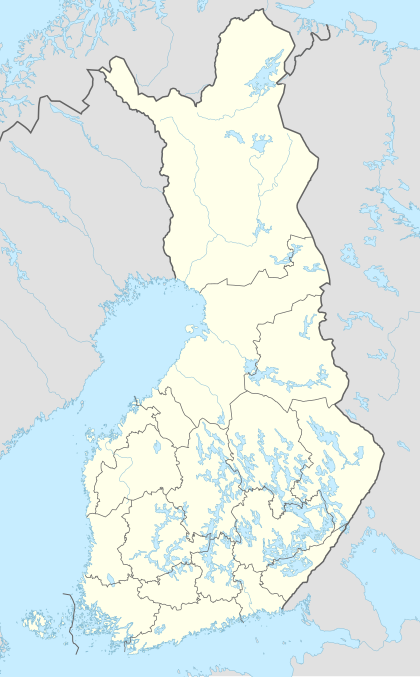Şimali Kareliya
| Şimali Kareliya | |||||
|---|---|---|---|---|---|
| Pohjois-Karjala Norra Karelen | |||||
|
|||||
| 63° şm. e. 30° ş. u.HGYO | |||||
| Ölkə | |||||
| Tarixi və coğrafiyası | |||||
| Əsası qoyulub | 2009 | ||||
| Sahəsi |
|
||||
| Saat qurşağı |
|
||||
| Əhalisi | |||||
| Əhalisi |
|
||||
| Digər | |||||
| pohjois-karjala.fi | |||||
|
| |||||
Şimali Kareliya (fin Pohjois-Karjala; isv. Norra Karelen) - Finlandiyanın vilayətidir. Bu vilayət Kaynuu, Şimali Savoniya, Cənubi Savoniya, Cənubi Kareliya vilayətləri və Rusiyanın Kareliya Respublikası ilə sərhəddir. Mərkəzi Yoensuu şəhəridir.
Şimali Kareliya dövlət səhiyyə işçiləri arasında məşhurdur.[3][4] 1960-cı illərdə Finlandiya sənayeləşmiş ölkələr içərisində ürək xəstəlikləri ölüm rəqəminə görə liderlik edir; Şimali Kareliya Finlandiyada ən yüksək ölüm rəqəminə sahib idi. 1972-ci ildə Şimali Kareliyadakı bu riski hədəf alan uzunmüddətli bir layihə həyata keçirildi.[5] Nəticədə xalq sağlamlığındakı yaxşılaşma hələ də əlamətdar sayılır və xalqın geri qalan hissəsi üçün bir modeldir.[6]
Rayonlar
[redaktə | mənbəni redaktə et]Vilayət 3 rayon və 13 kommunadan ibarətdir. 5 kommuna şəhər statusuna sahibdir. (Aşağıda qalın şriftlə göstərilib)
|
Yoensuu rayonu:
|
Mərkəzi Kareliya rayonu:
Pielinen Kareliya rayonu: |
Təhsil
[redaktə | mənbəni redaktə et]Şimali Kareliyadakı ali təhsil institutlarına daxildir:
- Şərqi Finlandiya Universiteti
- Şimali Kareliya Tətbiqi Elmlər Universiteti
- Riviera Peşə Təhsili və Təlimi
İstinadlar
[redaktə | mənbəni redaktə et]- ↑ https://www.maanmittauslaitos.fi/sites/maanmittauslaitos.fi/files/attachments/2021/01/Vuoden_2021_pinta-alatilasto_kunnat_maakunnat.pdf.
- ↑ http://pxnet2.stat.fi/PXWeb/pxweb/fi/StatFin/StatFin__vrm__vamuu/statfin_vamuu_pxt_11lj.px.
- ↑ "The North Karelia Project: 30 years successfully preventing chronic diseases" (PDF). International Diabetes Federation. 2012-03-08 tarixində orijinalından (PDF) arxivləşdirilib. İstifadə tarixi: 2012-08-06.
- ↑ "Finland's bold push to change the heart health of a nation" (ingilis). Knowable Magazine. 2018. 2022-07-11 tarixində arxivləşdirilib. İstifadə tarixi: 2020-12-28.
- ↑ Puska, P; Salonen, JT; Nissinen, A; Tuomilehto, J; Vartiainen, E; Korhonen, H; Tanskanen, A; Rönnqvist, P; Koskela, K; Huttunen, J. "Change in risk factors for coronary heart disease during 10 years of a community intervention programme (North Karelia project)". Br Med J (Clin Res Ed). 287 (6408). 1983: 1840–4. doi:10.1136/bmj.287.6408.1840. PMC 1550066. PMID 6423038.
After the second world war cardiovascular diseases, predominantly coronary heart disease, became the leading public health problem in most of the industrialised world. Mortality statistics and other studies showed that in the 1960s the highest heart disease mortality rates were observed in Finland, predominantly in men. Within Finland the highest rates were registered in eastern Finland and were particularly high in the county of North Karelia.
- ↑ "THE NORTH KARELIA PROJECT: FROM NORTH KARELIA TO NATIONAL ACTION". National Institute for Health and Welfare (Finland). 2014-07-15 tarixində orijinalından arxivləşdirilib. İstifadə tarixi: 2012-08-05.
In first five years of the North Karelia Project, for example, most of the reduction in cigarette smoking took place in the first year of the programme; most hypertensive individuals who brought their blood pressure under control achieved this by the end of the third year; dietary changes took place gradually over a five-year period; and, as noted earlier, at the end of five years, a net reduction in risk-factor levels was observed. Concerning mortality, CHD incidence and mortality rates started to decline surprisingly quickly after the start of the intervention in North Karelia. In the rest of the country, a similar decline started several years later. Thus a significant net change in favour of North Karelia was observed, especially in 1974 to 1979 (Salonen et al, 1983). Thereafter, although the decline in North Karelia continued, the net decline was gradually reduced. Thus maximal difference in favour of the intervention area was observed some 5-8 years after its start (Puska et al, 1995). For cancer mortality, a net reduction in favour of North Karelia could be observed much later, i.e., 5 to 10 years after the intervention commenced.

![Gerb[d]](http://upload.wikimedia.org/wikipedia/commons/thumb/6/66/Pohjois-Karjala.vaakuna.svg/135px-Pohjois-Karjala.vaakuna.svg.png)

